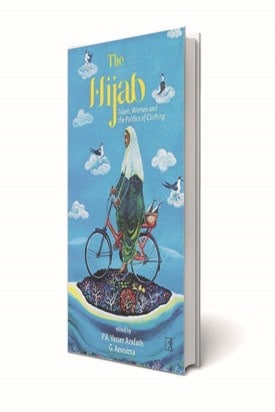Women’s clothing, of any length, has been a perennial point of contention. This social conservativeness mixed with communal politics led to what was termed as the Karnataka hijab controversy last year. That ‘controversy’ has now abated but questions persist: What does this piece of clothing mean to Muslim women, what made the saffronised Hindutva men swoop in, unsolicited, for the so-called emancipation of women from their so-called oppressive patriarchs, and where does education fall in all of these? These and several other questions are debated upon in The Hijab: Islam, Women and the Politics of Clothing, a collection of essays compiled by PK Yasser Arafath and G Arunima.
Penned largely by women, the Karnataka hijab issue serves as the crux of the book, but it delves into much more. From how the wearers see this headscarf not just as a religious symbol, but as something that protects them from the unwanted male gaze, unwanted politics, unwanted attempts to undermine India’s largest minority community to the basic idea of secularism enshrined in the Indian Constitution, right from its Preamble, the book has a lot to offer.

A mix of writers, offering both academic and personal narratives on the issue, adds much flair to the reading.
While it delves deep into the politics around the hijab and its historical context, what it means in Islam is somewhat missing, especially since it is mentioned right in the title. While much has been documented about the torment hijab-clad women in Udupi went through at the hands of saffron-clad Hindutva men, how this Islamic headscarf features in the Islamic scheme of things, the commentary within the community, feels missing. Given the fact that women in Karnataka were protesting for the hijab at the same time their contemporaries in Iran were protesting against it, again leaves us with a question—whether the garment is more more socio-political than religious, which is something the book fails to address.
A chapter dedicated to Iran where women underwent much torture and torment at the hands of a theocratic and brutal state in their protest against the state imposition of hijab reads incomplete. These women, who braved much oppression and showcased what feminist resilience should look like, deserved more nuanced and enough mention. Yes, the book largely focuses on south India, but given the contemporary occurrence of events, it is difficult to isolate the two if one wishes to truly understand the whole scheme of things.
Another part that is difficult to read is when veiling is termed as something that saves women from harassment. As a woman, it is not difficult to realise that the amount of skin showing is no deterrent for a harasser. A section where the writing sidetracks is when it uncritically talks of instances of imposition of hijab on women, making it read it like glorification of the practice.
For example, a 47-year-old woman named Asiya started wearing purdah after being asked by her sons-in-law. “What has to be pointed out here is that the desire of the sons-in-law for their mother-in-law to wear purdah comes from self-preventing any chance or non-moral or non-religious relations with her. In their community, the age gap between mother-in-law and their sons-in-law is sexually seductive. Perhaps that is why Asiya had to start wearing purdah,” the author writes. Another woman, named Sulaikha was under “tremendous pressure” from her daughters “to change” herself into purdah. “Covering themselves with purdah liberates women from the image of being an object of sex,” the author writes, conveniently extricating men from the whole issue.
The good parts of the book are the personal essays, especially the one written by Ambarien Alqadar, titled ‘Veiling/Unveiling’. Here, the writer pens the different relationships she and her mother had with the Muslim veiling, and her rebellion for her choice to not wear a hijab. “I chose to not wear the hijab and my parents’ difficult love found a way to support me. The fight one wages in the intimate sphere of the family is most often invisible, nevertheless for me it has been the hardest fight,” she writes in a poignant, and surprisingly, critical read.
Despite its lacking, the book is structured well, and the efforts put in by Arafath and Arunima to give space to diverse elements and opinions show.
The Hijab: Islam, Women and the Politics of Clothing
Edited by PK Yasser Arafath and G Arunima
Simon & Schuster
Pp 240, Rs 599








